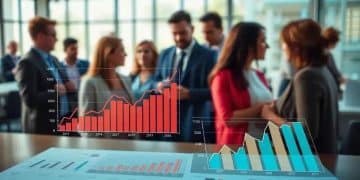Global economic recovery post-pandemic: what to expect

The global economic recovery post-pandemic involves key sectors like technology and healthcare, significant government policies, and addressing challenges such as supply chain disruptions and inflation to promote sustainable growth.
The global economic recovery post-pandemic is a hot topic today. We’ve all felt the ripple effects on our daily lives. What changes can we expect as nations work toward rebuilding their economies?
Understanding the global economic impact of the pandemic
The global economic impact of the pandemic has been profound and far-reaching. As countries struggled to cope with restrictions, many sectors experienced sudden downturns. Understanding these impacts is crucial for predicting future trends.
Immediate Effects on Key Industries
When the pandemic struck, industries like travel, hospitality, and retail faced severe challenges. Many businesses had to close temporarily or even permanently. This led to significant job losses and a rise in unemployment rates worldwide. For instance, the travel industry saw a drop in demand like never before, as people stayed home.
- Travel and tourism experienced dramatic reductions in revenue.
- Hospitality faced unprecedented layoffs.
- Retail shifted towards online sales but struggled with supply chain issues.
On the other hand, some sectors benefited from the situation. Technology firms, especially those offering remote work solutions, thrived. The need for digital transformation increased, pushing companies to adapt quickly. Businesses that embraced e-commerce and digital services were better positioned to survive.
Long-term Economic Changes
Looking beyond the immediate effects, the pandemic introduced lasting changes in the global economy. For one, remote work and online services are likely to become the norm rather than the exception. This shift has changed how businesses operate and employees interact with their work environments.
Furthermore, supply chains were disrupted significantly, revealing vulnerabilities in reliance on global networks. Companies are now reconsidering their sourcing strategies to reduce risks. Innovation and flexibility will be key attributes for businesses aiming to adapt to this new economic landscape.
As economies gradually recover, the focus will shift towards building resilience against future crises. For example, governments are likely to invest more in healthcare and technology to support economic stability.
Key sectors driving economic recovery
Several key sectors are driving economic recovery post-pandemic. Understanding these sectors helps us see where growth opportunities lie. As economies work to bounce back, certain industries are showing strong resilience and adaptability.
Technology Sector
The technology sector has become a vital component of recovery. The pandemic accelerated the shift to digital as businesses moved online. Companies that provide cloud computing, software solutions, and cybersecurity services are thriving.
- Increased demand for remote work tools.
- Growth in e-commerce platforms.
- Expansion of online education and training services.
This growth has not only created new job opportunities but also increased investments in technological advancements.
Healthcare Industry
The healthcare industry is another critical player. The pandemic highlighted the importance of robust healthcare systems. As nations prioritize health, investments in healthcare infrastructure have surged.
Innovations in telehealth and vaccine development have been significant. These changes improve accessibility to healthcare services. This sector’s growth is likely to continue as emphasis on public health rises.
Renewable Energy
Renewable energy is becoming more central to economic recovery strategies. Governments are focusing on sustainable practices and reducing carbon footprints. Investments in solar, wind, and other renewable sources are increasing.
- Job creation in green energy sectors.
- Support for research and development of clean technologies.
- Enhanced community engagement in sustainability efforts.
This sector holds promise for long-term economic growth and environmental benefits.
As we examine these sectors, we find that collaboration and innovation are essential for ongoing recovery. By focusing on key industries, economies can rebuild stronger and more sustainably.
Challenges faced in the recovery process

The challenges faced in the recovery process are numerous and complex. As countries strive to rebound from the pandemic’s effects, they encounter various obstacles that complicate their efforts.
Supply Chain Disruptions
One major challenge is the disruption in supply chains. Many businesses found it difficult to source materials due to lockdowns and transportation issues. These disruptions led to delays in production and delivery.
- Increased shipping costs added financial strain.
- Availability of raw materials fluctuated significantly.
- Manufacturers had to adapt quickly to changing circumstances.
These factors contributed to uncertainty in the market, making planning and forecasting difficult for many organizations.
Labor Market Adjustments
Another significant issue is labor market adjustments. The pandemic caused many people to change their job situations, leading to staffing shortages in key sectors. Businesses struggled to find qualified workers willing to return to the job market.
Additionally, many employees are reconsidering their work-life balance and career choices. As a result, companies faced challenging recruitment processes and higher wages to attract talent.
Inflation Concerns
Inflation is another challenge affecting recovery. Prices for goods and services have risen sharply in many areas, impacting consumers and businesses alike. This rise in costs has led to decreased purchasing power.
- Higher prices can slow consumer spending.
- Businesses may struggle to maintain profit margins.
- Long-term inflation can lead to economic instability.
These challenges illustrate the complexity of the recovery process. While there are signs of improvement in various sectors, the road ahead remains uncertain. Stakeholders must navigate these difficulties while exploring new opportunities for growth.
Role of government policies in economic recovery
The role of government policies in economic recovery is critical for shaping a nation’s path forward. After the pandemic, many governments implemented various measures to support their economies. These interventions aim to stimulate growth and address the challenges that arose during this period.
Fiscal Stimulus Packages
One of the primary tools used has been fiscal stimulus packages. Governments allocated significant funds to support businesses and individuals. This assistance helped maintain consumer demand and prevent deeper economic downturns.
- Direct payments to citizens boosted household spending.
- Support for small businesses helped them stay afloat.
- Investments in infrastructure created jobs and spurred growth.
Such measures played a crucial role in stabilizing economies during challenging times.
Monetary Policy Adjustments
In addition to fiscal policies, monetary policies also adjusted to support recovery. Central banks lowered interest rates to encourage borrowing and investment. These changes made it cheaper for consumers and businesses to access funds.
Quantitative easing became more common as well, with central banks purchasing government securities to inject liquidity into the economy.
Regulatory Reforms
Furthermore, regulatory reforms were necessary to adapt to the new economic landscape. Streamlining regulations helped businesses operate more efficiently. In some cases, governments provided temporary relaxations of regulations to expedite recovery processes.
- Reducing red tape improved business operations.
- Temporary support measures targeted sectors most affected by the pandemic.
- Policies promoting innovation fostered resilience.
These government initiatives have helped lay the foundation for economic recovery. The collaboration between public and private sectors is essential for achieving sustainable growth in the coming years.
Future outlook for global economies
The future outlook for global economies is shaped by various factors, including technological advancements, policy changes, and shifting consumer behaviors. As nations emerge from the pandemic, understanding these dynamics will be essential for predicting economic trajectories.
Technological Innovation
One major factor influencing future economies is technological innovation. The rapid advancement of technologies like artificial intelligence and automation is transforming industries. Businesses that adapt to these changes will likely thrive, while those that do not may struggle to keep up.
- The rise of remote work technologies is here to stay.
- Automation could enhance productivity in manufacturing and services.
- Startups in tech sectors are expected to lead new market trends.
These innovations can drive economic growth, but they also necessitate a rethinking of workforce skills and education.
Policy and Regulation Changes
Government policies will also play a critical role in shaping economic futures. Countries must balance between encouraging business growth and protecting public interests. New regulations around sustainability, for example, can encourage green growth while tackling climate change.
Investment in infrastructure will be vital as well, as it can create jobs and stimulate economic activity. Well-planned policies can create an environment where innovation flourishes.
Shifts in Consumer Behavior
Additionally, shifts in consumer behavior are reshaping markets. The pandemic has altered how people shop, travel, and interact with businesses. For instance, a greater emphasis on online shopping and contactless services is expected to persist.
- More consumers are prioritizing sustainable and ethical brands.
- Personalization and customer experience will become increasingly important.
- Health and safety measures will remain a priority in various sectors.
These changes can create new opportunities for businesses that recognize and adapt to evolving consumer preferences. Overall, while uncertainties remain, understanding these trends can better prepare economies for the future.
FAQ – Frequently Asked Questions about Global Economic Recovery
What are the key sectors driving economic recovery?
Key sectors include technology, healthcare, and renewable energy, all playing crucial roles in stimulating growth.
How do government policies impact economic recovery?
Government policies through fiscal stimulus, monetary adjustments, and regulatory reforms help stabilize and promote economic growth.
What challenges do economies face during recovery?
Challenges include supply chain disruptions, labor market adjustments, and inflation concerns, all of which can hinder progress.
What role does technology play in future economic outlook?
Technology drives innovation, enhances productivity, and shapes consumer behavior, playing a key role in the future of economies.





